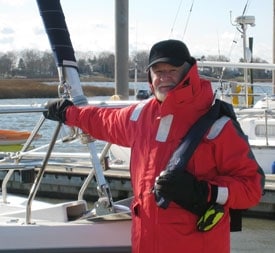
PerkinsST
1300 HoursDecember 18Sydney, Australia Today is a “lay day,” and my first chance to catch my breath. On Saturday we met most of the rest of our mates for the race. They were a diverse lot in almost every way: backgrounds, sizes, professions, and the like. However, as expected they did have a couple things in common. First, they’ve all had extensive sailing and offshore racing experience. This highlighted, of course, my “rookie status”. Second, it seemed like almost everyone had a nickname: “Fairweather,” “Jungle,” “Goldy,” “Frenchy,” to name a few. I felt like I was enrolled in the Navy’s Top Gun school. By the end of the day I was often identified as “Perk,” at least to “Jungle” (so named for his ability to climb a halyard like a tropical vine.) Sunday, yesterday, was our first day sailing. I should preface this part by saying that my recounting of what happened yesterday owes much to Ed (Eddo) Smith. Truth told, so much was going on that my mental state was pretty much the same as at my wedding the week before: I was happy to be there, but sufficiently awed by the experience that what actually happened was pretty much a blur! (For the record, I clearly remember saying, “I do” at the wedding, but I don’t recall a similar commitment for the Sydney to Hobart Race.) Before heading out we had a second tutorial on the operation of the water ballasting system. On each side are three tanks (basically double walled sections of the hull) that can be filled with seawater to level the boat. They are operated with a series of 12 valves, all operated from the companionway steps by pulling on ropes in the proper sequence. All this was explained over the roar of the engine, and I can’t say I got it down pat. Maybe by the end of the week I’ll feel more confident I could do it smoothing in a tacking duel with our direct competitor…the DHL Volvo 60. After lots of dragging around huge (read gigantic) sails in cramped spaced (including the dreaded “Anaconda”) we set out onto Sydney harbor. Our practice sail took us under the iconic “Harbour Bridge”, already rigged with New Years fireworks, and breathtakingly close to the downtown skyline and the beautiful Sydney Opera house. All the while being dodged by fleets of Lasers, windsurfers, Ynglings, 505s and speeding 49ers, impossibly rigged with jutting bowsprits and hiking platforms and iridescent Mylar mainsails that make them look like a swarm of dragonflies. It soon became clear that –though there was plenty of individual sailing experience on the boat — that didn’t automatically add up to a high performance team. On the way out we tore the tack (bottom corner) completely off our giant “Code 0” headsail. It is an upwind sail, but unlike our normal jibs which run up a slot in the forestay to a point two-thirds of the way up the mast, the Code 0 is hoisted unsupported to the top of the mast and trimmed to a spinnaker block on the transom. The accident post mortem concluded that we had over-tightened the backstay while the sail was up, pulling the mast tip back and overtensioning the leading edge of the sail. We ran into similar problems on the way back. A small tear in the spinnaker quickly spread from bottom to top and edge to edge as we tried to pull the sail down. Ironically, part of the problem seemed to be that people were confident in their ability and eager…maybe too eager…to lend a hand. Absent coordination, this led to problems. And on a boat like this little problems quickly become big ones. I alternated between the coffee grinder for the main (all that practice with the arm cycle machine actually paid off!) and the running backstays. The runners are a critical job, since the oversized mainsail means there is no permanent backstay. If one of the two backstay is not fully tightened at all times, there is a very real risk of breaking the mast at the deck level, and toppling it forward. Tonight Ed and I are meeting John Walker for a drink. At 84, John is the oldest skipper to do the race, and will be doing it in one of the smallest boats. I spent a lovely afternoon at his home on my last visit and John was, in part, my inspiration for doing the race myself. I’m really looking forward to seeing him at the Cruising Yacht Club. Tomorrow, back for another go with “Dragon,” as Goldy calls the Volvo. Let’s see if we can make a smooth running team out of this collection of experienced sailors!









